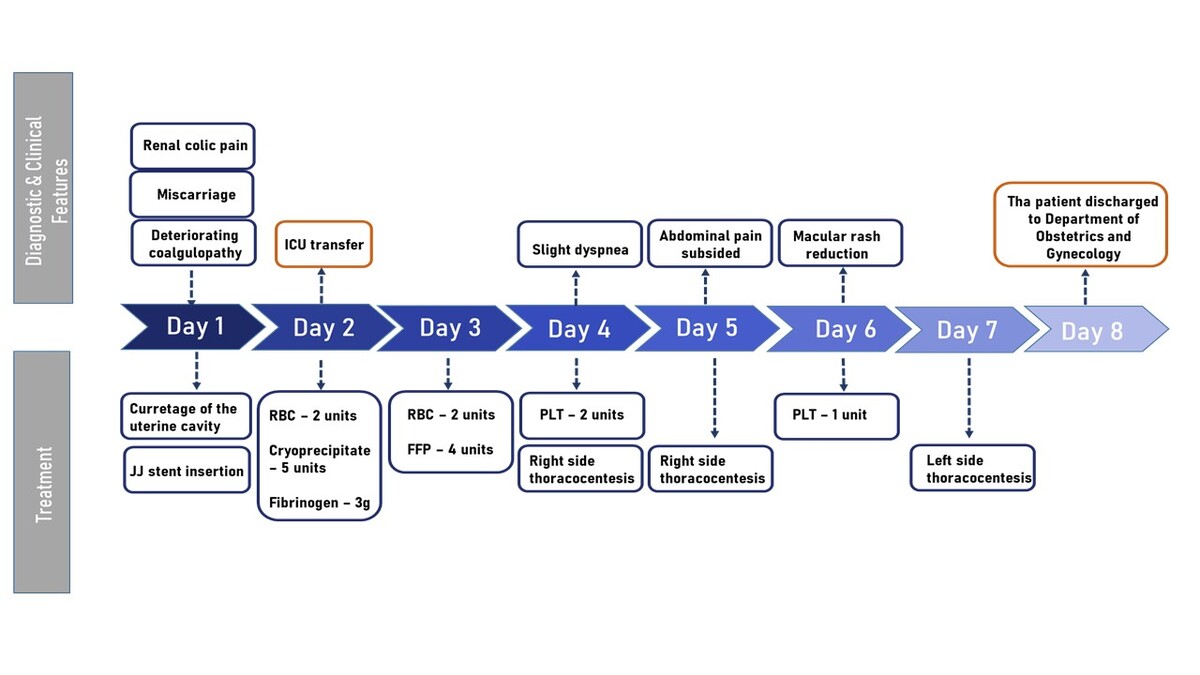CASE REPORT
Urinary tract infection as cause of a septic miscarriage and disseminated intravascular coagulation – case report and literature review
1
Student Research Group, Second Department of Anaesthesiology and Intensive Therapy, Medical University, Lublin, Poland
2
Second Department of Anaesthesiology and Intensive Therapy, Medical University, Lublin, Poland
Corresponding author
Zuzanna Paluch
Student Research Group, Second Department of Anaesthesiology and Intensive Therapy, Medical University, Lublin, Poland
Student Research Group, Second Department of Anaesthesiology and Intensive Therapy, Medical University, Lublin, Poland
J Pre Clin Clin Res. 2023;17(3):212-214
KEYWORDS
TOPICS
ABSTRACT
Urinary tract infection (UTI) is one of the most common bacterial infections which affectis 150 million people worldwide annually. Pregnant women are particularly vulnerable to UTIs. Untreated asymptomatic bacteriuria in pregnancy can develop into an acute state, leading to serious complications, such as sepsis, pulmonary oedema, acute respiratory distress syndrome, anaemia, spontaneous miscarriage, or preterm labour. All bacteriuria in pregnancy should be treated, and antibiotic choice in pregnancy should reflect safety for both the mother and the foetus. The case is presented of a 37-year-old woman in 20 Hbd pregnancy who was transferred to an Intensive Care Unit due to right-side renal colic symptoms caused by urinary tract obstruction. Despite immediate treatment, the next day, septic miscarriage and disseminated intravascular coagulation (DIC) occurred.
Paluch Z, Krawczyk M, Duda P, Rypulak E, Wichowska O. Urinary tract infection as cause of a septic miscarriage and disseminated intravascular
coagulation – case report and literature review. J Pre-Clin Clin Res. 2023; 17(3): 212–214. doi: 10.26444/jpccr/168416
REFERENCES (22)
1.
Giustozzi M, Ehrlinder H, Bongiovanni D, et al. Coagulopathy and sepsis: Pathophysiology, clinical manifestations and treatment. Blood Rev. 2021;50:100864. doi:10.1016/j.blre.2021.100864.
2.
Kutnik P, Szczukocka M, Borys M, et al. Procalcitonin dynamics, lactates, and haemoglobin serum levels might be a useful predictive tool of mortality in patients undergoing veno-venous extracorporeal oxygenation membrane support. Single centre experience. Anaesthesiol Intensive Ther. 2019;51(5):343–347. doi:10.5114/ait.2019.90235. PMID: 31893600.
3.
Onichimowski D, Będźkowska A, Ziółkowski H, et al. Population pharmacokinetics of standard-dose meropenem in critically ill patients on continuous renal replacement therapy: a prospective observational trial. Pharmacol Rep. 2020;72(3):719–729. doi:10.1007/s43440-020-00104-3. Epub 2020 Apr 16. PMID: 32301057; PMCID: PMC7329797.
4.
Angus DC, Linde-Zwirble WT, Lidicker J, et al. Epidemiology of severe sepsis in the United States: analysis of incidence, outcome, and associated costs of care. Crit Care Med. 2001;29(7):1303–10. doi:10.1097/00003246- 200107000-00002.
5.
McLellan LK, Hunstad DA. Urinary Tract Infection: Pathogenesis and Outlook. Trends Mol Med. 2016;22(11):946–957. doi:10.1016/j. molmed.2016.09.003.
6.
Kalinderi K, Delkos D, Kalinderis M, et al. Urinary tract infection during pregnancy: current concepts on a common multifaceted problem. J Obstet Gynaecol. 2018;38(4):448–453. doi:10.1080/014436 15.2017.1370579. Epub 2018 Feb 6. PMID: 29402148.
7.
Geerlings SE. Clinical Presentations and Epidemiology of Urinary Tract Infections. Microbiol Spectr. 2016;4(5). doi:10.1128/microbiolspec.UTI-0002-2012. PMID: 27780014.
8.
Habak PJ, Griggs, Jr RP. Urinary Tract Infection In Pregnancy. In: StatPearls. StatPearls Publishing, Treasure Island (FL); 2022. PMID: 30725732.
9.
Glaser AP, Schaeffer AJ. Urinary Tract Infection and Bacteriuria in Pregnancy. Urol Clin North Am. 2015;42(4):547–60. doi:10.1016/j. ucl.2015.05.004. Epub 2015 Aug 1. PMID: 26475951.
10.
Bookstaver PB, Bland CM, Griffin B, et al. A Review of Antibiotic Use in Pregnancy. Pharmacotherapy. 2015;35(11):1052–62. doi:10.1002/ phar.1649. PMID: 26598097.
11.
Gajewski P, et al. Interna Szczeklika 2022 – Mały Podręcznik. 14th ed. Kraków; 2022.
12.
Eschenbach D, Treating spontaneous and induced septic abortions. Obstet Gynecol. 2015;125(5):1042–1048. doi:10.1097/AOG.0000000000000795.
13.
Erez O. Disseminated intravascular coagulation in pregnancy – Clinical phenotypes and diagnostic scores. Thrombosis Res. 2017;S56–S60. doi:10.1016/S0049-3848(17)30069-5.
14.
Levi M, Toh CH, Thachil J, et al. Guidelines for the diagnosis and management of disseminated intravascular coagulation. British Committee for Standards in Haematology. Br J Haematol. 2009;145(1):24–33. doi:10.1111/j.1365-2141.2009.07600.x.
15.
Wada H, Thachil J, Di Nisio M, et al. Harmonized guidance for disseminated intravascular coagulation the International Society on Thrombosis and Haemostasis and the current status of anticoagulant therapy in Japan: a rebuttal. J Thromb Haemost. 2013;11(11):2078–9. doi:10.1111/jth.12366.
16.
Gando S, Wada H, Thachil J. Scientific and Standardization Committee on DIC of the International Society on Thrombosis and Haemostasis (ISTH). Differentiating disseminated intravascular coagulation (DIC) with the fibrinolytic phenotype from coagulopathy of trauma and acute coagulopathy of trauma-shock (COT/ACOTS). J Thromb Haemost. 2013;11(5):826–35. doi:10.1111/jth.12190.
17.
Piwowarczyk P, Borys M, Kutnik P, et al. Unfractionated Heparin Versus Subcutaneous Nadroparin in Adults Supported With Venovenous Extracorporeal Membrane Oxygenation: a Retrospective, Multicenter Study. ASAIO J. 2021;67(1):104–111. doi:10.1097/ MAT.0000000000001166. PMID: 32404610.
18.
Rattray DD, O’Connell CM, Baskett TF. Acute disseminated intravascular coagulation in obstetrics: a tertiary centre population review (1980 to 2009). J Obstet Gynaecol Can. 2012;34(4):341–347. doi:10.1016/S1701-2163(16)35214-8.
19.
Erez O, Novack L, Beer-Weisel R, et al. DIC score in pregnant women-a population based modification of the International Society on Thrombosis and Hemostasis score. PLoS One. 2014;11;9(4):e93240. doi:10.1371/journal.pone.0093240.
20.
Font MD, Thyagarajan B, Khanna AK. Sepsis and Septic Shock – Basics of diagnosis, pathophysiology and clinical decision making. Med Clin North Am. 2020;104(4):573–585. doi:10.1016/j.mcna.2020.02.011.
21.
Borsuk-De Moor A, Rypulak E, Potręć B, et al. Population Pharmacokinetics of High-Dose Tigecycline in Patients with Sepsis or Septic Shock. Antimicrob Agents Chemother. 2018;62(4):e02273–17. doi:10.1128/AAC.02273-17. PMID: 29358291; PMCID: PMC5913959.
22.
Iba T, Levi M, Levy JH. Sepsis-Induced Coagulopathy and Disseminated Intravascular Coagulation. Semin Thromb Hemost. 2020;46(1):89–95. doi:10.1055/s-0039-1694995.
Share
RELATED ARTICLE
We process personal data collected when visiting the website. The function of obtaining information about users and their behavior is carried out by voluntarily entered information in forms and saving cookies in end devices. Data, including cookies, are used to provide services, improve the user experience and to analyze the traffic in accordance with the Privacy policy. Data are also collected and processed by Google Analytics tool (more).
You can change cookies settings in your browser. Restricted use of cookies in the browser configuration may affect some functionalities of the website.
You can change cookies settings in your browser. Restricted use of cookies in the browser configuration may affect some functionalities of the website.


